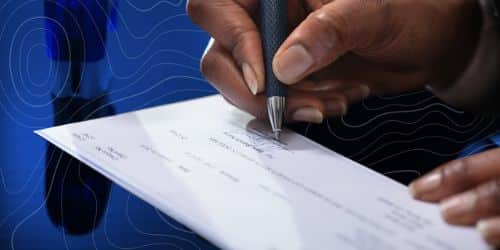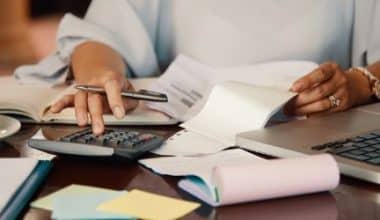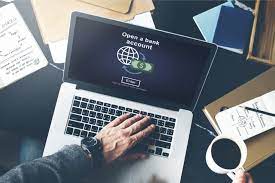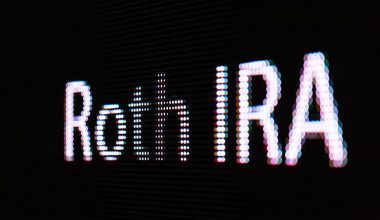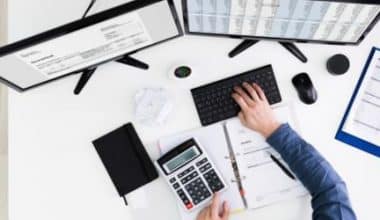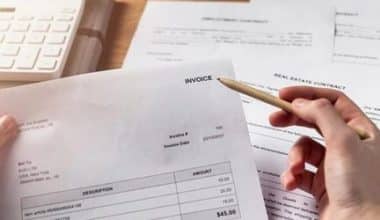Many people believe that cashier’s checks are risk-free. After all, the bank, and not the buyer, pay out the cash. But it’ll thrill you to know that even though checks seem safer than cash, there have been cases of check scams, particularly cashier’s checks. How, then, do you verify that the cashier’s check is real? Also, what happens when you deposit a fake cashier’s check? Find out in this article.
What are Cashier’s Check Scams?
Cashier’s check scams nearly always include someone handing you a genuine-looking check or money order and asking you to wire them money or send them things in exchange.
You discover that the check issued to you was fraudulent after you deposit or cash it and send the money.
Common Cashier’s Check Scams
#1. Scams Involving Work-From-Home Positions
You get payments in the check or cashier’s checks, which you are meant to deposit into your account and transfer to someone else. These schemes, which are frequently marketed as work-at-home check processing jobs, are frequently troublesome. You may be laundering money for criminals in some circumstances. In other circumstances, the first few payments are good, but after they’ve established your trust, you’ll get a fake check and lose money.
#2. Scams Involving Mystery Shoppers
You are notified that you have been selected to serve as a mystery shopper. Afterward, you are given a cashier’s check and instructed to deposit it into your bank account. You are directed to spend a portion of your funds at specific stores, send a portion of your funds to a third party by wire transfer, and keep the remaining. If the cashier’s check turns out to be fake, you will lose the money you spent and sent.
#3. Cashier’s Checks Used to Buy Products and Services
You sell things, and a buyer gives you a cashier’s check for the agreed-upon sum. You mail the products to the buyer only to discover that the cashier’s check is counterfeit.
#4. Scams in Foreign Lotteries
You won a foreign lottery, or someone close to you died, and you inherited a large sum of money. The letter is frequently accompanied by a cashier’s check. The check is intended to help cover the taxes and expenses associated with claiming your reward money, according to the fine print. You just deposit the check into your account and send a portion of the funds to the folks who sent it to you to settle the taxes and fees. You get to keep the remainder of your deposit as well as the entire amount of the reward money you “earned.” Of course, the money never arrives, and you are out the fees you have paid.
#5. Rental Property Scams
Someone interested in renting your property is willing to pay the first and last month’s rent (as well as the security deposit) with a cashier’s check before ever seeing the property since they are supposedly starting a new job. The day after you deposit the check, they tell you there is a problem with the project and they won’t be there, so they don’t need the rental. You may keep the security deposit, but they would prefer that you refund a portion of the rent. When you send the return, you’ll discover that the check was fake.
Tips for Avoiding Cashier’s Check Scams
#1. Know Who Is Sending You the Check
Accepting checks, even cashier’s checks, from people you don’t know is risky. If the check is a forgery, pursuing a remedy may be challenging.
#2. Check to See if the Check Is Real
Call or go to the banking institution’s branch where the check is drawn. The banking institution should be able to assist you in determining whether or not the issued check is legitimate. Don’t rely on the phone number for the banking institution stated on the check; it could be a forgery. Conduct your investigation and locate the institution’s actual phone number.
#3. Check to See if the Check Has Cleared
Call your banking institution and verify that the check has cleared and the funds have been entered into your account.
#4. All Papers Should Be Saved
Keep any documentation related to a cashier’s check. This documentation may be useful if something goes wrong.
Why Are There More Counterfeit Check Scams?
The cashier’s check is typically regarded as a safer method of payment than cash. Despite recent scandals, bailouts, and scams committed by some of the largest banks in the United States, most of us still trust checks issued by banks.
Current technological capabilities are also contributing to the rise in check fraud. High-quality printers and scanners make counterfeiting quite simple. Names, true account and routing information, and even authentic-looking watermarks are included on the checks. Some forgeries seem so authentic that even bank tellers can’t tell the difference.
The law itself aids the counterfeiter in committing his crimes. Your bank is required by federal law to make the monies from the cashier and other bank checks available within one to five business days. The check may take up to two weeks to clear the financial system for your bank to receive payment from the issuing bank.
Read Also: Cashier’s Check vs Money Order: Which is Best?
Some counterfeit checks are so good that they transit across banks for several weeks before the fake is uncovered. This gives the fraudster plenty of time to steal the stuff and flee, leaving you or your company to “take the hit.”
If you deposit a cashier’s check that turns out to be a scam, your bank will reverse the deposit. If you have already spent some or all of the money, you must return it to the bank. Your only option would be to sue the individual who wrote the check-in in the first place.
Unfortunately, catching a counterfeiter is extremely tough, especially if he committed his crime some weeks before it was discovered. Many of the criminals involved in these scams are based in foreign nations, making it much more difficult to track them down and prosecute them.
What to Do If You Are a Cashier’s Check Scam Victim
If you feel your business or you have been a victim of bank check fraud, register a complaint with each of the following agencies (as applicable):
- Fill out the Federal Trade Commission’s online complaint form.
- If the check was mailed, the US Postal Inspection Service.
- Your state’s or municipality’s consumer protection agency. The National Association of Attorneys General (NAAG) website includes a list of all state and territory Attorney Generals in the United States.
How to Verify a Cashier’s Check
You can make efforts to ensure the legitimacy of a cashier’s check. Follow these steps to verify a cashier’s check to prevent becoming a victim of fraud.
Quick Verification Steps
- Don’t accept it if it is for more than the buying price.
- Look for a watermark, micro print, or a warning sign: mistakes.
- Request verification from the issuing bank by visiting or calling them.
Here’s a closer look at how you can verify that a cashier’s check is real:
#1. Never Accept a Cashier’s Check if There Are Indications of a Scam
One classic cashier’s check scam involves someone overpaying for an online transaction; therefore, don’t take a cashier’s check for more than the purchase price.
For example, a buyer from outside the United States sends you a cashier’s check that appears to be from a bank in the United States and requests that you refund the overage separately. According to federal law, proceeds from a deposited cashier’s check must be available within one business day. The buyer is nowhere to be found when the phony check is detected days or weeks later. The bank might hold you liable for the fraud because you made the deposit.
Aside from the overpayment fraud, other typical scams to be aware of include:
- Prize or lottery awards
- Payment in advance for mystery shopping via check deposits and wire transfers
If the circumstances appear to be too wonderful to be true, they most likely are.
#2. Examine the Cashier’s Check
Cashier’s checks frequently carry a unique feature exclusive to the bank and typically indicate what to look for. Look for a watermark or microprint on the check if it says it has one. If it is not present, the check may be invalid.
Typos are another red flag that a check is a forgery, as fake cashier’s checks are occasionally sent from abroad senders.
#3. Go to the Bank or Call It
Only the bank that issued the cashier’s check has the ability to truly verify it. Keep in mind that you cannot verify a cashier’s check online, but there are other options.
If the check was issued by a bank with a branch near you, the best course of action is to take it to the bank and check verification. A larger bank, such as PenFed, would have an established procedure for cashier’s check verification. There is no fee to verify a cashier’s check.
If you are unable to visit the bank in person to trace a cashier’s check, independently confirm the phone number stated on the check, then call the bank and verify that the check is verified. To verify a cashier’s check, all banks require the following information:
- Number of the check
- Name of the person who presented you with the check
- Amount of payment
How to Cash a Cashier’s Check
It is preferable to cash or deposit a cashier’s check at the bank that issued it, as this facilitates the validation process. Otherwise, you must cash it at another bank with which you have an account. You must show identification proving that you are the payee of the check, as well as your bank account number or ATM card.
Is Cashier’s Check Safer Than Cash?
Using a cashier’s check has various advantages, one of which is that it is safer than cash. This type of check is ideal for higher cash amounts and may save you from purchasing multiple money orders. It is more secure than a money order, and some payees may expressly request it.
The money is backed by the bank and is referred to as “guaranteed funds.” Landlords may need a cashier’s check as a security deposit. In addition to being dependable funds, this is a means to demonstrate that the potential tenant has a current bank account.
Why The Cashier’s Check Is Safer Than Cash
#1. Cashier’s Checks Are Acceptable for Large Purchases
Larger purchases are often made with cashier’s checks. Although policies vary by bank, there is normally no upper limit for a cashier’s check. With a cashier’s check, the payee often has faster access to a bigger portion of the funds.
#2. Cashier’s Checks Are More Secure to Use
Money orders are often considered less secure than cashier’s checks. Although check scams involving fake cashier’s checks and money orders exist, a cashier’s check has more security features than a standard money order. A cashier’s check is also backed by a bank, which may have more clout with the recipient than a check-cashing store.
How do you spot a fake cashier’s check?
A cashier’s check should already have the payee’s name printed on it (this is done at the bank by a teller). An invalid check has an empty payee line. A cashier’s check is only considered valid if it has the bank’s contact information printed on it. Many counterfeit checks don’t include or use a valid routing number.
Can a cashier’s check bounce after it clears?
The full value of a valid cashier’s check must be paid in cash, or the funds must be immediately available for withdrawal when the check is ordered from a bank. A cashier’s check cannot be dishonored because it has already been cashed.
Why would someone want to pay with a cashier’s check?
When dealing with large sums of money or in situations where cash or personal checks are not acceptable, cashier’s checks are a safe and reliable alternative. A cashier’s check cannot be dishonored because it is guaranteed by the bank or credit union from which it was drawn.
Do banks verify cashier’s checks before cashing?
A cashier’s check’s legitimacy can only be confirmed by the issuing bank. Keep in mind that a cashier’s check cannot be checked online, but there are other options. Taking the check to the issuing bank and asking for verification is your best bet if the bank has a local branch.
How secure is a cashier’s check?
Cashier’s checks are checks that are signed by a bank employee and are guaranteed by the bank. To make a large purchase, cashier’s checks are often the preferred payment method due to their perceived security. Bank, rather than the buyer, guarantees payment of this check.
Why would a scammer send a check?
Some of it could be a refund for an item you sold online, while some could be “prize” money from a lottery or a sweepstakes. The scammer’s end goal is always the same: to get you to deposit the fake check so that you can wire money back to them. Dont fall for it.
What does a real cashier’s check look like?
The words “Cashier’s Check” should be printed at the top of the check. The name of the bank, the account number, and the bank’s routing number should all be printed on the front of the check. Watermarks are an additional security feature that can be added to cashier’s checks.
In Conclusion,
You’ve probably heard that if something seems too good to be true, then it probably is. As such, it’s best not to rely on money from a cashier’s check or any other sort of check unless you know and trust the person you’re working with and only after your bank confirms that the check has cleared. As much as the cashier’s check is safer than cash, you should verify any check you receive because forgeries might take weeks to identify and disentangle. The bottom line is that you are accountable for any money you withdraw against that check until the bank certifies that the monies from the check have been deposited into your account.
Cashier’s Check Scams FAQs
Can you get scammed with cashier's check?
As a matter of fact, yes. Many individuals have fallen victim to scams employing a forged cashier’s check.
How can I verify if a cashier's check is real?
If the check was issued by a bank with a branch near you, the best course of action is to take it to the bank and verify it.
What happens if I deposit a fake cashier's check?
If you deposit a fake cashier’s check, your bank will reverse the deposit.
